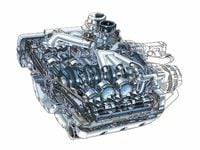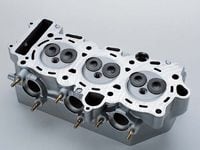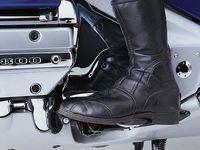Lord of the Wings
Recasting an American icon in a sportier direction
It's 1993. You're in a room full of Honda heavyweights, deciding who gets to head the new-generation Gold Wing project. Let's see...the single most profitable model in the Honda lineup, a half-million copies in circulation since its 1975 unveiling, the two-wheeled Honda flagship.... No pressure there. So who gets the job? Masanori Aoki, large-project leader for the NSR250R at just 33 years old Honda's youngest LPL ever. Check his resume. The CBR250RR was his, plus the CBR400RR and the CBR600F3. It's perfect. He's a sportbike guy.
A sportbike guy? What sort of corporate nonsequitur is that? Maybe the same kind that took Honda Motor Company from a one-man show to a household word in any language you can name. It all makes sense, really. The Gold Wing, as it transitioned through 1000, 1100, 1200 and, finally, 1500cc iterations, had become bigger, heavier and a lot more ponderous--and a lot less fun for anyone with a trace of sportybike DNA. Gold Wings were for the chronologically challenged, and since Honda's new flagship couldn't become the harbinger of Sansabelt slacks yet to come, 1990s-style luxury was out. Performance was in, and Aoki-San would be the man to redefine it--just as soon as he figured this whole touring thing out.
"First I had to learn English," Aoki says. "I lived in the United States from 1993 to 1996. During that time I had to learn how people were enjoying the Gold Wing. I went to many rallies--Wing Ding, Honda's Homecoming and Hoot, Americade, and Sturgis. Basically, I went everywhere." Aoki's everywhere included ZIP codes lucid tourists fear to tread, like the 2200 miles between Anchorage, Alaska and Seattle, Washington, where he learned many things. "It's a long way between gas stations out there," he says. "Our original target for the new Gold Wing was 234 miles on one tankful, but we ultimately got more than that."
In focus-group research beginning in 1994, Honda heard America's long-distance motorcyclists order the same thing in different ways: more performance. Just as American luxury cars had morphed from 1980s land yachts to 2000 cruise missiles such as Cadillac's 141-mph Seville STS, Aoki-San knew his new GL had to be lively, yet maintain the tradition of first-class comfort.
"We set out to keep 80 percent of the [current] Gold Wing's touring capability," Aoki says. "That's a vital foundation. My job is to add more fun factor, to build a Gold Wing with the kind of acceleration and handling people normally associate with motorcycles. Even the sound is important," he says. "It's another reason you ride a motorcycle instead of driving a car. The GL1500 engine has an electric motor feel to it. Good power and torque, very linear, but it signs off too early in the rev range. I wanted more character, more excitement." He wasn't waiting around to get it, either.
Returning to Japan on February 1, 1996, Aoki and one of the largest development teams in Honda history went to work on what would be the 2001 Gold Wing. In February of 1997, the first of four top-level engineering forums decided basic chassis and ergonomic dimensions. As it turns out, fundamental engine configuration was determined in 1975.
"The Gold Wing is the flat cylinder design," Aoki insists. After testing the signature, horizontally opposed layout in four-, six- and eight-cylinder denominations, the six won going away. Juggling incompatible dynamics such as exhaust emissions, noise, weight, fuel mileage, horsepower, torque and driveability made finding the magic engine size difficult. Testing on American roads, Aoki's team started with a 1657cc mutation of the existing 1520cc six. After dissecting everything from the current 1500 to a two-liter beast, input from American riders on American roads finally set the 2001 six's displacement at 1832cc. And because the new engine would be a stressed chassis member (no rubber mounts to squelch vibration), attaining Gold Wing smoothness meant moving beyond the flat six's theoretically perfect primary and secondary balance factors. For starters, that meant scrutinizing the balance factor of any engine bit that spins to cut high-load harmonic tremors.
Given the new bike's more sporting mission and Honda's familiarity with nonferrous skeletal systems, even greeters at Wal-Mart predicted an aluminum-framed Gold Wing months ago. Meanwhile, Aoki and company set chassis numbers such as wheelbase and steering geometry in January of 1998. Ponder the dynamics involved in sporting around on 792 pounds of motorcycle (plus fuel, two people, personal effects and that full-scale stuffed Alf on the trunk) and the strategic advantages of aluminum make even more sense here than on a CBR600F4. Just ask Aoki-San.
"The new Gold Wing's higher dynamic performance levels demand more of key structures such as the frame and swingarm," he says. "Those demands and limited space made the internal frame shapes very complex." That complexity delivered a claimed 119 percent more lateral rigidity and 77 percent more torsional stiffness than the GL1500's steel-pipe chassis, and weighs 25 pounds less.
Credit the single-sided Pro-Arm swingarm for much of that, and for making rear tire changes radically easier when the time comes. What's more, because each part of the aluminum frame can handle several roles, there are just 31 components in the dual-spar GL1800 frame--compared with 130 pieces of steel in a GL1500 skeleton.
From an antidive system that works in concert with Honda's Linked Braking System (and available antilock brakes) to an electrically adjustable shock-spring preload system and a new drive shaft damper, there are 36 newly patented technologies inside this thing.
Although every contour of the new design was calculated to communicate the strength beneath, the bike still had to look like a Gold Wing. According to American Honda's Gary Christopher, focus-group feedback helped outline a bike with less bodywork to play up the new hardware. People wanted a more athletic Gold Wing, wanted it to look the part. "If the bike was lighter," says Christopher, "it should look lighter." Honda designers on both sides of the Pacific generated more than 100 prospective design sketches, and in October of 1997 they had a winner. Adding an unprecedented extra step to the design process, both Honda Research America and Honda R&D; Japan rendered a 1/8-scale clay model from that final sketch. In February of 1998, an internal design challenge commissioned one life-size mockup incorporating the best facets of both designs.
Meshing those powerful new ideas with adaptations of established ones, Aoki constantly looked for relationships connecting seemingly independent systems. "By moving the rider into the pocket of neutral air behind the fairing," he says, "we were able to design a smaller faring with 10 percent less aerodynamic drag. Moving the rider forward also creates an additional two inches of seating room for Gold Wing passengers." Moving the rider forward meant moving the engine ahead too, which helps handling. Finding room for the rider's feet and legs meant clipping the bottom-rear corner from each cylinder bank, but doing that required a new parallel valve train that puts 32,000 miles between adjustments. Seven years of orchestrating thousands of potentially discordant details into one harmonious piece may have taken its toll on Aoki-San. If it did, you won't see any evidence when he laughs like the kid who just discovered you can launch flaming strawberry Pop-Tarts across the kitchen by pinning them in the toaster (don't try that at home!), or when he does an a cappella version of The Monkees', Daydream Believer. After burning seven years of midnight oil on this thing, the bottom line is simple. "I just hope people like the bike," he says. --T.C.
Wing Tech
A peek beneath the plastic of Honda's new GL
A few hundred miles will prove Honda's new Gold Wing is more than the sum of its parts, but it takes an added critical look to discover how much more. Stroll around the world's largest production motorcycle engine for a bit and do the math.
Its 1832 cubic centimeters are divided among six cylinders, fed by two 40mm throttle bodies packing six 50-psi Keihin fuel injectors, two digital fuel-injection maps and an ignition map for each cylinder. Then there's the obligatory army of acronyms; from LBS (linked braking system) to ABS (antilock braking system) to RACV (Rotary Air Control Valve, which optimizes idle speed under all manner of conditions). A staggeringly powerful 1100-watt alternator pays the electric bill run up by six microprocessors, four 55-watt headlight bulbs, two 35-watt driving lights, electric reverse gear, plus a quartet of 25-watt stereo speakers--the business end of an AM/FM/CD sound system, replete with six-disc changer. Moreover, we haven't even talked about the first aluminum spar skeleton ever fitted to a touring rig, or the remote-control trunk lid.... All that adds up to grand total of part numbers that, were it ever made public, could trigger a firestorm of lawyer-to-lawyer cell-phone calls that would bring play at golf courses across America to a grinding halt. But this much we know. Add up all the separate part numbers in a new Honda Civic and subtract 12. That's what goes into every 2001 Gold Wing.
Champagne Dreams
BMW's luxo-boat takes on Honda's new GL
Eighteen months ago we pitted BMW's then-new K1200LT against the aging Gold Wing and the BMW won. Then, we said a new GL was on the way--suggesting it could be a 2000cc V-8, of all things--that might vanquish the hotshot Beemer.
Welcome to the future as we knew it, only the Gold Wing is 1800cc of flat-six and the Beemer is the same as it ever was. Now we ask: Does the GL reclaim the crown?
First a reality check. We called around and confirmed our suspicions that the BMW and the Honda are not actively cross-shopped. We found that the Gold Wing buyer is intensely loyal to the model and that riders stepping up to the big K-bike are likely to be coming from other BMWs, but may also be considering the LT against a Harley. Really.
BMW attempted a truly futuristic motorcycle with the LT, one in which all the elements are joined in a way that some brochure writer might call "synergistic." The saddlebags flow brazenly into the side panels and swoop up toward the topbox. The taillight spans the back of the bike in a way that confirms, "These aren't your father's Krausers." It's definitely a single designer's vision.
Honda's closed the style gap with the 2001 GL, but it still looks slightly frumpier than the Beemer. For those transgressions, the Honda responds with more capacity and superior one-lock, three-latch accessibility to the luggage. BMW makes you lock and unlock each bag separately. With the optional CD changer you can write off a good portion of the LT's right-side saddlebag.
Neither bike wants for amenities, but the approaches taken by BMW and Honda indicate the opposed corporate cultures. For example, the GL gets a nutty, push-button, electro-hydraulic spring preload adjuster for the shock and an electric headlight-beam adjuster. And a windshield that can be raised or lowered manually only on the side of the road.
BMW makes you raise the seat and twist a knob to change rear preload (neither bike has any more suspension adjustability than that), and reaiming the headlight calls for reaching forward to a mechanical dial. And the windshield magically raises and lowers (changing its rake as it goes) at the push of a bar-mounted switch. Praise to BMW for giving you a simple means of getting a dirty or wet windshield out of your line of view and thereby providing the most useful application of gadgetry.
Even as the BMW was perspiring to stay astride of the old Gold Wing in acceleration, the story today is just how viciously the new Honda body-slams the K-bike. In power output, the gulf widens to more than 20 horsepower and nearly 40 foot-pounds of torque. At the strip (where few full-dressers hang out, we understand), the BMW gets pegged by more than a second in the quarter-mile, 1.3 seconds to 60 mph, and, most tellingly, by a whopping 3.5 seconds in the 60-80 mph top-gear roll on.
Out on the highway, it's this last statistic you appreciate most. Fully loaded, the throttle-pinned K-LT oozes forward from 60 mph, making it an agonizing trip around that gravel-spewing truck. Don't even consider passing without a downshift, sometimes two. Tall gearing--comparatively taller even than the low-redlined GL's--hampers roll-on, but helps create a truly serene atmosphere. At 80 mph, the Beemer creates a generous still-air pocket and the laydown-four under all that plastic issues forth but a distant hum. Not so much as a tingle gets to the bars or pegs.
BMW has worked hard, obviously, to potty-train the formerly raucous K-series engine, and this effort is nowhere more evident than in the fuel-injection calibration. What at first seems only to be very soft "carburetion" turns out to be deliberate mellowing of throttle response. If you feel for it, you can tell the computer's massaging the injection to keep the bike from lurching or surging and the result is a motorcycle that does exactly what you ask of it, no more and no less. Here we'll give higher marks to BMW because the Honda's injection is sharper and occasionally harder to modulate. What's more, the BMW's clutch takeup is broader and more progressive than the GL's.
If BMW made up ground on engine civility--and let's not take away from the GL's mighty 110 foot-pounds of grunt--then the Honda has countered with a more agile chassis. Ultimately, it comes down to the Honda carrying more weight a lot more effectively; the differential feels like 100 pounds in the Honda's favor, but the BMW is actually 60 pounds lighter.
The Honda's six keeps the mass low, while BMW has piled a lot of stuff atop the panting four-cylinder. As a result, the K-LT feels perilously top-heavy at parking-lot speeds, creating an intimidating situation for even average-sized riders. While confidence blooms on the Honda, experienced riders still cast a wary glance at the horizon as the BMW comes to a standstill. Worse, that funky Telelever front end, not exactly full of feedback in other applications, is positively numb in the LT; it's not helped by a steering damper that makes the bike feel like the steering-head bearings are tight (if it had any, that is). While we're praising the Honda, consider that while the BMW's antilock brakes are quite good--although the rear lacks feel--the GL's are phenomenal.
On the ergonomics issue we think BMW has held course and taken the lead. For the new GL, Honda moved the rider forward and not all of us found that position to be an improvement. According to our measurements, the BMW offers two inches more room from the seat to the bar, which has slightly less rise. And although the LT's pegs are slightly farther forward and higher than the GL's, the resulting seating position provides more useful room for the rider, and, coupled with a firmer and plainer saddle, creates a better, more comfortable perch for most riders. That seat, heated no less, can be adjusted to one of two heights in seconds. (We should note in discussing the ergo issue that small riders loathe the BMW.)
Who wins? Tough question to answer, particularly as the bikes have such different personalities and strengths; we're not surprised they're infrequently on the same shopping list. Because we're power junkies, we'll give the nod to the Honda, but confess that an uprated K-LT--just how big can you make that four-hole brick, BMW?--might once again turn the tables. Check back in a year and a half, won't you? --Marc Cook

























/cloudfront-us-east-1.images.arcpublishing.com/octane/VZZXJQ6U3FESFPZCBVXKFSUG4A.jpg)
/cloudfront-us-east-1.images.arcpublishing.com/octane/QCZEPHQAMRHZPLHTDJBIJVWL3M.jpg)
/cloudfront-us-east-1.images.arcpublishing.com/octane/HXOUJXQWA5HBHGRO3EMJIGFMVI.jpg)

/cloudfront-us-east-1.images.arcpublishing.com/octane/3TIWWRV4JBBOLDVGRYECVVTA7Y.jpg)
/cloudfront-us-east-1.images.arcpublishing.com/octane/KIX5O23D5NAIBGFXBN3327DKZU.jpg)
/cloudfront-us-east-1.images.arcpublishing.com/octane/7GJYDUIPXRGMTMQKN6ONYOLBOU.jpg)
/cloudfront-us-east-1.images.arcpublishing.com/octane/MUQLOVLL2ZDGFH25ILABNBXKTI.jpg)
/cloudfront-us-east-1.images.arcpublishing.com/octane/TNOU5DNE2BC57MFPMGN2EIDXAM.jpg)
/cloudfront-us-east-1.images.arcpublishing.com/octane/GTCXACQGJ5HAPDTGWUQKDEH44E.jpg)
/cloudfront-us-east-1.images.arcpublishing.com/octane/S35YGSEMEZB4BLTDJTSZPF4GLA.jpg)
/cloudfront-us-east-1.images.arcpublishing.com/octane/5UOT6HPX2JFMRJAX6EH45AR4MQ.jpg)
/cloudfront-us-east-1.images.arcpublishing.com/octane/OKWOJWAKP5EP3OACCRRWPCIX2Q.jpg)
/cloudfront-us-east-1.images.arcpublishing.com/octane/2WF3SCE3NFBQXLDNJM7KMXA45E.jpg)
/cloudfront-us-east-1.images.arcpublishing.com/octane/G4MG6OUCJNBSHIS2MVVOTPX65E.jpg)
/cloudfront-us-east-1.images.arcpublishing.com/octane/IIGGWFOTOJGB7DB6DGBXCCMTDY.jpg)
/cloudfront-us-east-1.images.arcpublishing.com/octane/QSTCM6AVEZA5JJBUXNIQ3DSOF4.jpg)
/cloudfront-us-east-1.images.arcpublishing.com/octane/U4I7G625B5DMLF2DVIJDFZVV6M.jpg)
/cloudfront-us-east-1.images.arcpublishing.com/octane/B6XD6LS6IVCQPIU6HXDJSM3FHY.jpg)
/cloudfront-us-east-1.images.arcpublishing.com/octane/ICL63FEDDRDTTMINYICCEYGMDA.jpg)
/cloudfront-us-east-1.images.arcpublishing.com/octane/FCGZHQXRBZFLBAPC5SDIQLVF4I.jpg)
/cloudfront-us-east-1.images.arcpublishing.com/octane/WNOB6LDOIFFHJKPSVIWDYUGOPM.jpg)

/cloudfront-us-east-1.images.arcpublishing.com/octane/X33NU3E525ECRHXLNUJN2FTRKI.jpg)